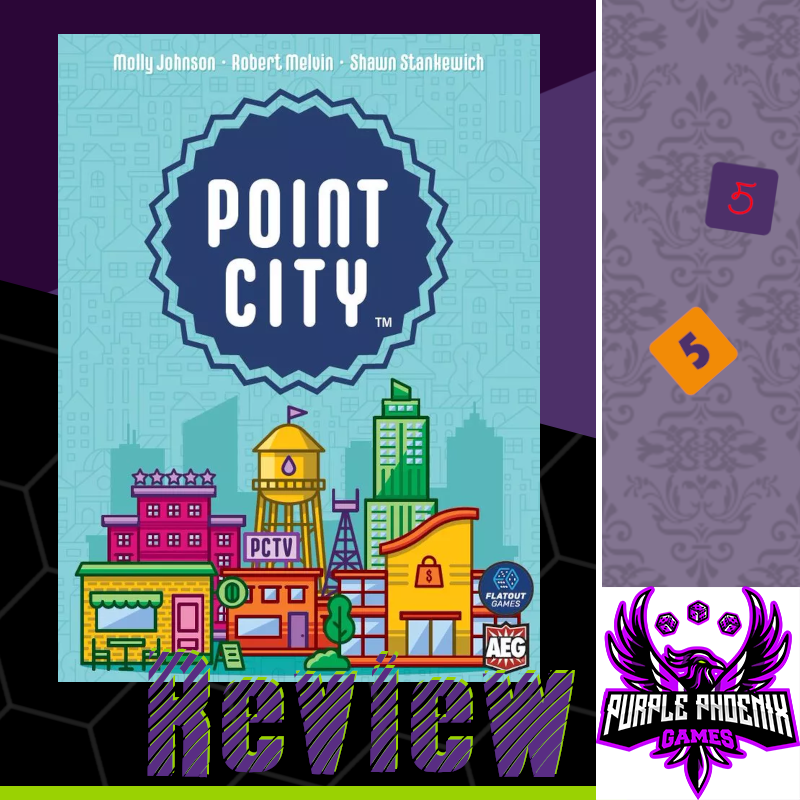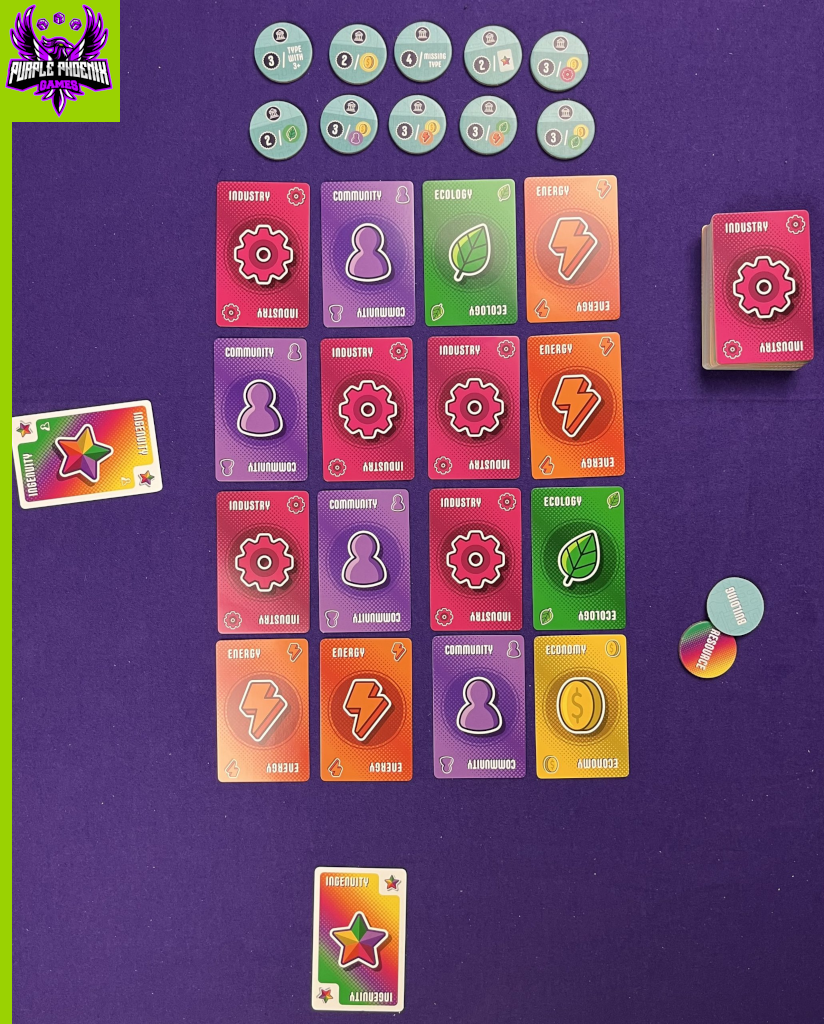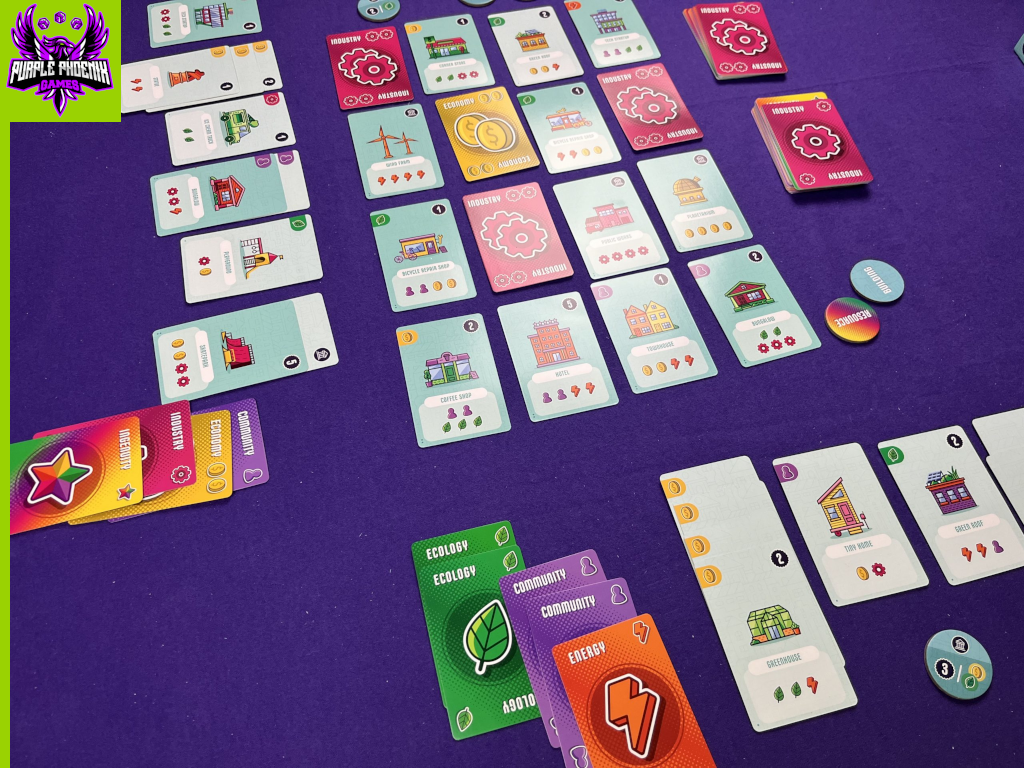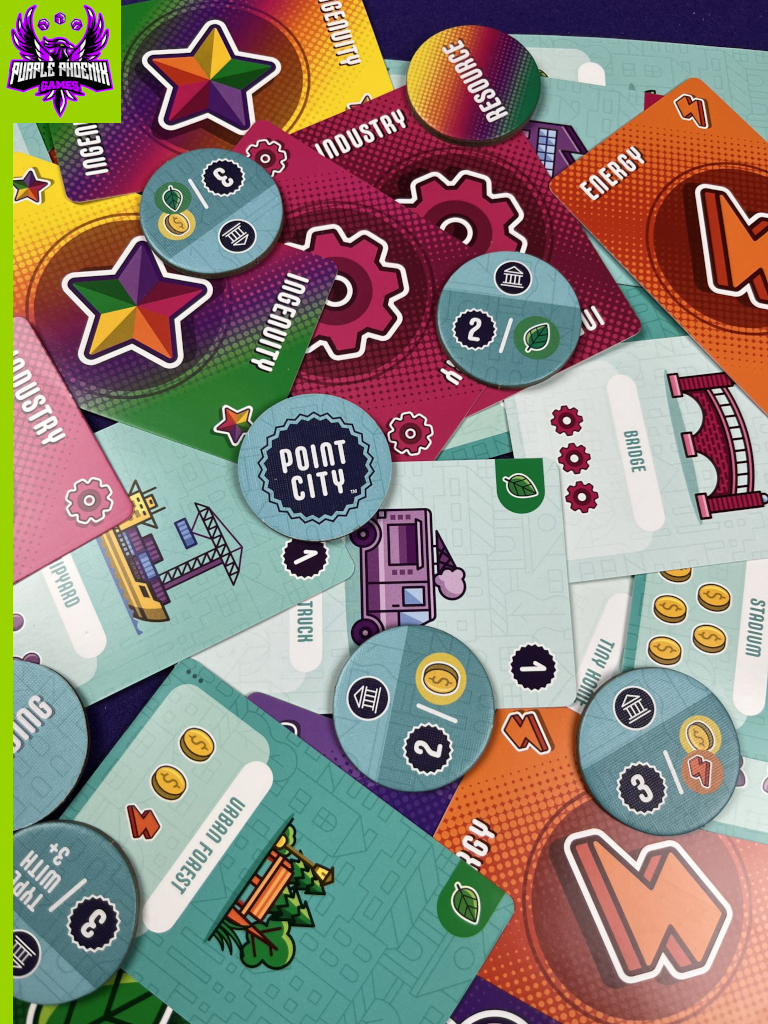
And for the next installment from my AEG GenCon 2023 experience is Point City. I guess you could call it a sequel to the popular Point Salad, also from AEG. But this new iteration is unique and different enough to stand strong on its own. Keep reading to see if you agree!
| Point City (2023) | AEG |
| 1-4 Players | 15-30 Minutes |
| Ages 10+ | BGG Weight – 1.61 / 5 |
Disclaimer: We were provided with a copy of Point City for the purposes of this review. What you see pictured below is a finalized production copy of the game. -L
Point City is a city-building game of drafting and set collection. Played over a series of rounds, players will be drafting cards and constructing buildings in an attempt to score the most end-game VP. To setup for a game, first create the Building/Resource deck as described in the rules according to player count. Those cards form the Draw Pile, and from the Draw Pile you will create the Market grid – a 4×4 grid of cards, Resource-side up to start the game. Shuffle the Civic Tokens face-down, select a number based on player count, flip them face-up, and set them into a supply. Each player takes a Starting Resource card, one of which has a Starting Player symbol. The game is now ready to begin! Picture below is the setup for a 2-player game.

On your turn, you will always either Draft 2 cards from the Market, or Draw 2 cards from the Draw Pile. To Draft cards from the Market, you must select 2 orthogonally adjacent cards to be added to your tableau. Resource cards can always be drafted, and are simply added to your tableau. Building cards each have a required Resource cost, so you may only Draft a Building card if you already have the required Resources in your tableau. If you choose to Draw 2 cards from the Draw Pile, simply take them and add them to your tableau. You may not Draw a card from the Pile and take a card from the Market – both cards must come from the same source, regardless of which action you choose to take.
In order to construct a Building, you must pay the requisite Resource cost listed on the card. You can pay that with Resource cards, placing them into the Discard pile. Some Buildings will provide you with permanent Resources after they have been constructed, so those can be used to ‘pay’ for future Building cards as well. Most Building cards have a listed VP value, and once they are constructed, you will score those points at the end of the game. Some Building cards have a Civic Building icon, and when you construct a Civic Building, you may then select an available Civic Token to take into your tableau. Civic Tokens earn you end-game points for specific sets of Buildings/Resources you collect over the course of the game.
Once you have either Drafted or Drawn your 2 cards this turn, paying Resources for Buildings or collecting Civic Tokens if applicable, your turn ends. The Market is refilled as described in the rulebook (Resource cards are replaced with Buildings, and vice versa), and the round moves to the next player. The game continues in this fashion until the Market is no longer able to be refilled – all players will have played exactly 17 turns. The game end is triggered, and players count up their points from constructed Building cards and any Civic Tokens they may have. The player with the highest score is declared the winner!

All in all, the gameplay is really simple – on your turn you draft/draw 2 cards. That’s it. But that’s where the simplicity ends. The strategy of this game is heightened the longer the game goes on. At the start of the game, it really is simple as the Market consists of only Resource cards. You’ve got a good chance there to stock up on Resources for future turns. But as Resources get drafted, they are replaced by Buildings. And since you can only draft orthogonally adjacent cards from the Market, you really have to strategize which Buildings you want, or simply which ones you can even afford. And with the game setup, the Building cards get more powerful (and simultaneously more costly) as the game progresses. Can you collect the right Resources to construct Buildings that will not only give you end-game points, but can provide permanent Resources for future turns? It is a delicate balance between constructing Buildings simply for lots of VP or deciding to construct ‘cheaper’ Buildings because they give you another permanent Resource. The same can be said for Civic Buildings. They provide no end-game VP, but allow you to take a Civic Token. And if you play your cards right (literally), that could boost your score at the end of the game.
Point City is in no way a major brain-burner or a game that’ll eat up your entire game night. But there is a fair amount of strategy that is ever-changing as the game progresses. Another neat element? The way the Market is refilled between player turns. If you took a Resource, it is refilled with a Building card, and vice versa. That means that the Market is drastically changing between players, and your strategy has to be adaptable. There really is no ‘right’ strategy to ensure victory, and that keeps the gameplay engaging and refreshing.
When it comes to components, AEG is a beast. This game consists of a deck of cards and cardboard tokens, but they are high quality and well-made! The artwork of the cards is colorful and clear, and the symbology of the game is comprehensible and doesn’t have me reaching for the rulebook for clarification every turn. So although this game isn’t component-heavy, it’s a solid production from AEG.
As you can see from our rating graphic, Travis and I are big fans of this game. The ease of learning the rules, teaching the game, and playing the game create a relaxed atmosphere to enjoy this neat little city builder. Like I mentioned earlier, Point City isn’t going to totally burn your brain, but it’ll get your gears turning without taking all night to play. I think this game could probably be categorized as a filler game, but I think it can hold its own as well. We were already fans of Point Salad, and Point City has just made us love this family of games even more. Purple Phoenix Games gives this a civil 10 / 12. If you want something relatively small that packs a big punch, I would highly recommend Point City!

